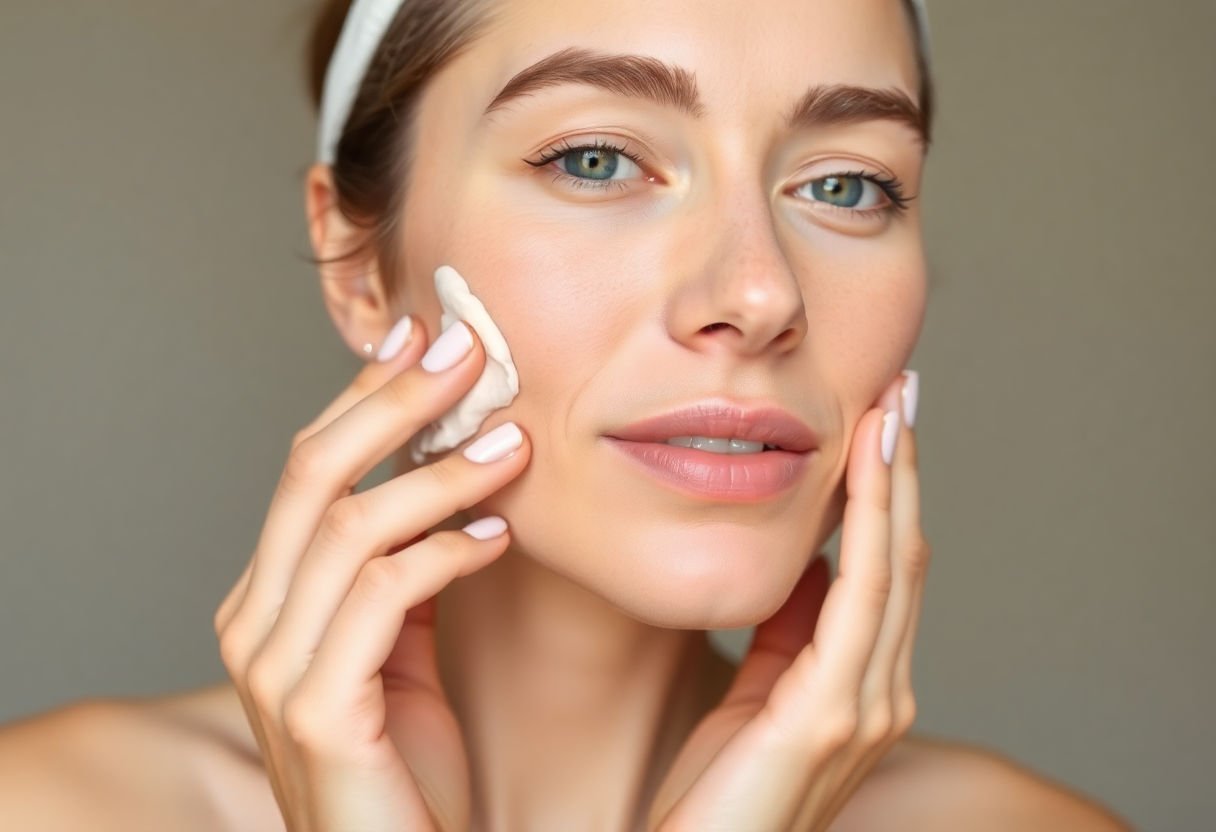Retinol is a game-changing ingredient widely celebrated in facial skincare for its potent effects on skin renewal and regeneration. Expanding its use to body care can transform your skin’s texture and tone, leaving it visibly smoother and more radiant. This guide delves into the multitude of benefits retinol offers for body skin, from boosting cell turnover to reducing fine lines. By learning how to select the right products and incorporate them into your routine, you can optimize your skincare regimen, avoid common pitfalls, and embrace a holistic approach for more luminous skin.
Key Takeaways
- Start your retinol body care regimen slowly to build skin tolerance and minimize potential irritation.
- Choosing the right retinol products suitable for your skin type is essential for achieving effective results.
- The benefits of incorporating retinol into your body care routine include improved skin texture and tone.
- Regular moisturizing is crucial to counteract dryness often associated with retinol use.
- Consulting a dermatologist can provide personalized guidance, especially for first-time retinol users or those with sensitive skin.
The Benefits of Retinol for Your Body
Retinol, widely celebrated for its transformative effects on facial skin, offers equally compelling benefits when applied to the body. By promoting increased cell turnover, retinol aids in the rejuvenation of the skin, resulting in fresher, smoother layers emerging from beneath the surface. This acceleration of skin renewal can significantly reduce the appearance of fine lines, particularly in often-overlooked areas such as the neck and chest.
In addition to its anti-aging properties, retinol effectively enhances skin tone and texture, addressing common concerns such as uneven pigmentation and roughness. By breaking down dead skin cells and facilitating their removal, retinol contributes to a smoother, more even surface. This can be particularly beneficial for individuals seeking to diminish the appearance of sun damage or age spots on the body.
Further, retinol has been noted for its ability to manage and reduce breakouts on the body, acting as a preventative for acne in areas like the back and shoulders. By unclogging pores and minimizing sebum production, retinol provides a cleaner, clearer complexion.
To capitalize on these benefits, it’s essential to incorporate retinol thoughtfully into your body care regimen. A measured approach will ensure your skin adapts well, unlocking the full potential of this powerful ingredient without overwhelming or irritating. Regular use of retinol can lead to visibly healthier skin, underscoring its efficacy beyond the confines of facial skincare.
Selecting the Right Retinol Products
When considering retinol for body care, it’s crucial to select products tailored to your specific needs. Not all retinol products are created equal; they differ in concentration, formulation, and suitability for different skin types. Here’s what to look for when choosing the right retinol products for your body.
Concentration and Formulation:
- Retinol concentrations can range from 0.1% to 1%. Beginners or those with sensitive skin should start with a lower concentration to minimize irritation.
- Look for products labeled as “body lotions” or “creams” that contain retinol. These formulations are generally designed for larger application areas and contain moisturizing agents to counteract dryness.
Skin Type Considerations:
- For sensitive skin, seek out formulations that include soothing ingredients such as aloe vera or chamomile.
- If your skin is particularly dry, opt for a cream-based product that is rich in emollients to help lock in moisture.
- Individuals with oily or acne-prone skin might benefit from lightweight, non-comedogenic formulations that won’t clog pores.
Specific Concerns:
- If targeting areas with uneven skin tone or dark spots, retinol products combined with brightening ingredients like vitamin C can enhance results.
- For those aiming to reduce the appearance of fine lines and wrinkles on the body, choose a product that also contains hyaluronic acid, which helps to plump and hydrate the skin.
Selecting the right retinol product is a critical step in harnessing its benefits while minimizing potential irritation. Carefully consider your skin’s needs and adjust your choices accordingly to achieve optimal results for a radiant, even-toned body.
Guidelines for Introducing Retinol to Your Regimen

Introducing retinol into your body care regimen requires caution and preparation to ensure the best results without irritation. Begin by performing a patch test to assess your skin’s sensitivity to retinol. Apply a small amount of the product to a discreet area, such as the inner arm, and wait 24 hours to observe any reactions.
Once you have confirmed tolerance, it is advisable to start with a low concentration of retinol, gradually increasing use as your skin adapts. Initially, apply retinol-based products 1-2 times per week, monitoring your skin’s response. If well tolerated, you can slowly increase the frequency of application, typically up to every other night over a period of several weeks.
Incorporate retinol into your routine at night, as retinol increases the skin’s photosensitivity and can be less effective when exposed to sunlight. Additionally, always moisturize after using retinol to counteract potential dryness or flakiness, and use sunscreen during the day even if you apply retinol at night.
It’s crucial to listen to your skin. If you notice redness, peeling, or discomfort, reduce the frequency of application, or switch to a lower concentration formula. Consulting with a dermatologist can provide personalized guidance, ensuring that the introduction process is safe and effective for your specific skin type and concerns. By following these structured steps, you can comfortably incorporate retinol into your regimen, reaping its benefits while minimizing any adverse effects.
Common Mistakes and How to Avoid Them

Incorporating retinol into your body care routine can yield tremendous benefits, but several common mistakes can hinder its effectiveness. Understanding these pitfalls will help ensure you achieve optimal results without adverse effects.
One of the most frequent mistakes is applying too much retinol too quickly. Retinol is a potent ingredient, and the skin requires time to adjust. To avoid this, start with a lower concentration and gradually increase usage as your skin builds tolerance. This approach minimizes the risk of irritation and flakiness.
Another common error involves neglecting to moisturize adequately. Retinol can be drying, particularly for those with sensitivities. To counteract this, pair your retinol application with a rich moisturizer, ensuring the skin remains hydrated and supple. Moisturizing not only enhances results but also aids in comfort and skin barrier protection.
Failing to perform a patch test is another oversight that can lead to adverse reactions. Always test a small amount on an inconspicuous area before using the product on larger surfaces. This precaution is crucial for identifying any potential allergies or sensitivities in advance.
Additionally, some users make the mistake of discontinuing sunscreen usage. Retinol increases the skin’s sensitivity to sunlight, making sun protection indispensable. Apply a broad-spectrum sunscreen daily, regardless of the weather, to protect against UV damage and prevent further skin complications.
Lastly, combining retinol with incompatible products can diminish results or cause irritation. Avoid using retinol with strong acids or exfoliants unless otherwise advised by a dermatologist. By being aware of these common mistakes and taking steps to avoid them, you can effectively harness the power of retinol in your body care regimen.
Pairing Retinol with Other Skincare Products

To effectively incorporate retinol into your body care regimen, it is crucial to understand how to pair this potent ingredient with other skincare products. This ensures you maximize its benefits while minimizing potential irritation.
Moisturizers: Retinol can often lead to dryness; therefore, integrating a rich moisturizer into your routine is essential. Products containing hyaluronic acid or glycerin can help, as they lock in moisture and enhance skin elasticity. Apply these hydrating agents after retinol to help soothe the skin and maintain its moisture barrier.
Niacinamide: Known for its calming properties, niacinamide pairs exceptionally well with retinol. It can help reduce redness and irritation, making it a great complement for those new to retinol usage or with sensitive skin. Apply niacinamide in the morning and reserve retinol for your nighttime routine to balance your skincare regimen.
Exfoliants: Be cautious when using chemical exfoliants, such as glycolic or salicylic acid, with retinol. Over-exfoliation can lead to skin irritation. If you’re incorporating chemical exfoliants, use them on alternate days or as directed by your dermatologist to prevent over-sensitization.
Antioxidants: These are beneficial when used alongside retinol, as they protect the skin from free radical damage and enhance the overall anti-aging effects. Vitamin C, a powerful antioxidant, works well when applied in the morning, allowing retinol to work its transformative magic overnight.
Layering Considerations: Allow sufficient time between applying retinol and other active ingredients. This practice ensures each product is absorbed effectively and reduces the chance of interactions that may compromise their efficacy.
Retinol and Sun Protection

Incorporating retinol into your body care regimen requires diligent attention to sun protection. Retinol, a derivative of vitamin A, accelerates cell turnover and can make the skin more sensitive to sunlight. To safeguard your skin while reaping the benefits of retinol, it’s crucial to integrate a comprehensive sun protection strategy.
First and foremost, applying a broad-spectrum SPF 30 or higher daily on areas treated with retinol is non-negotiable. Rain or shine, the ultraviolet (UV) rays can penetrate cloud cover and even windows, posing a threat to unprotected skin. A quality sunscreen not only prevents sunburn but also protects against premature aging and skin cancer.
For optimal protection, consider a two-step approach: apply retinol at night and SPF in the morning. This ensures that while the retinol works overnight to improve your skin’s texture and tone, the SPF provides round-the-clock protection against harmful UV exposure.
Additional measures to bolster your sun defense include wearing protective clothing. Long-sleeved shirts and wide-brimmed hats can significantly reduce the risk of UV damage on sensitive, retinol-treated skin.
Paying attention to environmental factors is also vital. Avoiding direct sunlight during peak hours, typically from 10 a.m. to 4 p.m., can minimize risk and enhance your results.
Incorporating these protective measures maximizes the efficacy of retinol, allowing you to enjoy its transformative benefits without the sun’s detrimental effects. Consistent sun protection is essential for maintaining healthy, radiant skin while utilizing retinol in your body care routine.
Addressing Sensitivity and Adverse Reactions

Incorporating retinol into a body care regimen can be transformative, but it’s essential to be mindful of potential sensitivity and adverse reactions. Some individuals experience redness, peeling, or dryness when using retinol, which can discourage continued use. However, these effects can often be managed with the right approach.
Start with a Patch Test: Before fully integrating retinol into your routine, conduct a patch test on a small, inconspicuous area of the body. This can help gauge your skin’s initial reaction and minimize potential widespread irritation.
Gradual Introduction: Begin by applying retinol-infused products every other day or even less frequently. As your skin builds tolerance, gradually increase the frequency. This slow introduction helps minimize irritation and allows your skin to adjust effectively.
Moisturizing is Key: Retinol can disrupt the skin’s barrier, causing dryness. Counteract this by applying a generous amount of a rich moisturizer after using retinol. Look for moisturizers containing hydrating ingredients like hyaluronic acid or ceramides.
Consider Alternatives: For those with highly sensitive skin, alternatives such as retinaldehyde or bakuchiol may provide similar benefits with reduced irritation. These alternatives are often less potent yet maintain effectiveness in improving skin texture and tone.
Consult a Dermatologist: If adverse reactions persist, seek advice from a dermatologist. A professional can recommend appropriate products or modifications to your regimen to ensure safety and efficacy.
By carefully managing sensitivity, you can enjoy the full benefits of retinol without compromising skin comfort, leading to a healthier, more radiant appearance.
Conclusion
Incorporating retinol into your body care regimen enhances your skin’s texture and appearance, offering evident benefits with consistent use. It facilitates increased cell turnover while improving fine lines and overall tone. As this potent ingredient becomes a staple, proceed mindfully—start gradually, avoid common mistakes, and combine it tactically with other products. With diligence and proper sun protection, retinol use can significantly transform your skin’s health and radiance, paving the way for a future of informed skincare practices and confidence in your body’s natural glow.
Frequently Asked Questions
How often should I apply retinol to my body?
It is recommended to start applying retinol to your body once or twice a week to allow your skin to build tolerance. Gradually increase usage as your skin adjusts, typically over several weeks.
Can retinol cause dryness, and how should I address it?
Retinol can cause dryness, particularly when first introduced. To combat this, ensure that you hydrate your skin with a rich moisturizer following retinol application.
How long will it take to see results from using retinol?
Visible improvements in skin texture and tone can typically be noticed after 4-12 weeks, depending on individual skin type and the frequency of retinol use.
Is it safe to use retinol during the day?
Retinol is typically recommended for nighttime use due to its sensitivity to sunlight. If used during the day, applying a broad-spectrum SPF is crucial to protect your skin.
What should I do if my skin experiences irritation from retinol?
If irritation occurs, decrease the frequency of use and ensure you’re using a moisturizer. Consider consulting a dermatologist if the irritation persists.
